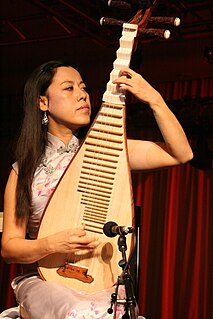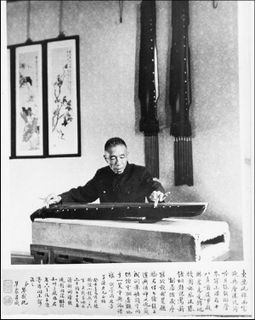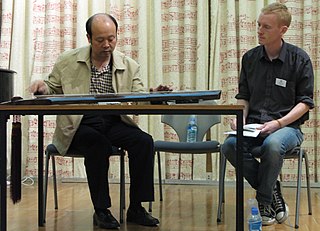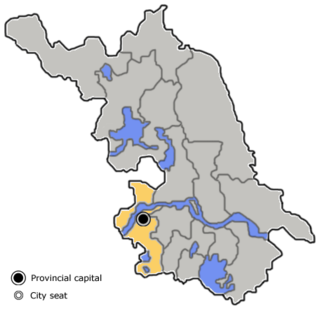
The Central Conservatory of Music is China's leading music school. Its campus is in the Xicheng District of Beijing, China, near Fuxingmen Station. It is a Chinese Ministry of Education Double First Class Discipline University, with Double First Class status in certain disciplines.
Wu Zhaoji (吳兆基), also known as Xiangquan, was born in Hunan in 1908, China. At the age of 4, his family moved to Suzhou, where he lived the rest of his life until his death in 1997. Raised in a musical family, he learned the guqin from his father, and in 1921 became a student of Wu Jinyang. From a young age, he enjoyed sports and martial arts. In 1928 he began studying the Yang Style of Tai-chi with Chen Weiming. One year later, he became a student of Li Shangyuan, who is a student of Hao Weizeng a descendent of the Wu (Martial) Style Taichi family. After many years of study he created his own style of tai-chi based on Daoism.
The Han Chinese, who make up some 92% of the population of China, play heterophonic music in which the musicians play versions of a single melody line. Percussion accompanies most music, dance and opera.

The se is an ancient Chinese plucked zither. It has 25–50 strings with moveable bridges and a range of up to five octaves.

Cheng Yu is a Chinese musician. She is internationally renowned as a performer of the pipa, a Chinese four-stringed lute, but also plays the guqin, a seven-stringed zither, and is a virtuoso, scholar and specialist of Chinese music.
Gong Yi is a guqin master from Shanghai, presently one of the instrument's leading figures. Born in Nanjing, he trained first under several local players before proceeding to the Shanghai Conservatory where he absorbed a range of styles from such prominent masters as Zhang Ziqian, Xu Lisun, Gu Meigeng, and Wei Zhongle. Gong Yi has had, since the 1950s, a varied career performing, teaching, composing, and researching under the auspices of several institutions and ensembles, most notably the Shanghai Chinese Orchestra of which he was director and sole guqin player. In guqin circles he is particularly noted for his efforts toward integration of the instrument into the conservatory mainstream.

Zha Fuxi, also known as Zha Yiping (查夷平) was a leading player and scholar of the guqin. Born in Jiangxi, he started learning guqin in his childhood. In 1936, he co-founded the Jinyu Qin Society (今虞琴社) which later became one of the major national musical organizations for the guqin.
The notation of the guqin is a unique form of tablature for the Chinese musical instrument, with a history of over 1,500 years, still in use today.
The London Youlan Qin Society is a London-based qin society serving guqin players in the UK. Of the three major qin societies of the West, this society was the most informal but still the most active in terms of regular events and yajis.
Wu Jinglüe (吳景略) is considered one of the most important guqin players of the 20th century and was also an active researcher and teacher. He was born in the town of Xitang, Changshu County, near Suzhou in Jiangsu, China, and died in Beijing.
The history of the Guqin, an ancient Chinese musical instrument, is a long one that spans 3,000 years. Although similar, it should not be confused with another Chinese zither instrument, the guzheng, which has bridges.
The playing techniques of the guqin, sometimes called fingerings, are more numerous than those of any other Chinese or Western musical instrument. They are also complex and full of symbolism.

Zhang Ziqian, a famous seven-string zither qin player, was born in Yangzhou, Jiangsu Province, China, during the late Qing Dynasty. He began studying the guqin with a guqin master Suo Shaotao at the age of thirteen. In the 1930s, Zhang moved to Shanghai and worked as an accountant at a salt factory. In Shanghai, he met Zha Fuxi and Peng Zhiqing who were active qin players then. They frequently played the guqin together and Zhang's playing skills were greatly influenced by them. In 1936, Zhang, Zha, Peng and other masters founded Jin Yu Qin She, a qin society. In 1956, Zhang became a guqin performer by being appointed as a member of the state-run Shanghai Minzu Yuetuan ; and a guqin teacher at the Shanghai Conservatory of Music in 1960.
Li Quan was born in Qiqihar, Heilongjiang Province on 9 December 1973. He is a martial artist who studied under famous masters, such as Grandmaster Dai Kang.

Wudang quan is a class of Chinese martial arts.
Yu Shuishan is one of the master contemporary guqin players and contributors. He is a Professor of Architecture in the College of Arts, Media and Design at the Northeastern University, a fourth generation Mei’an School guqin player, and the founder of North America Mei'an Society (北美梅庵琴社).














